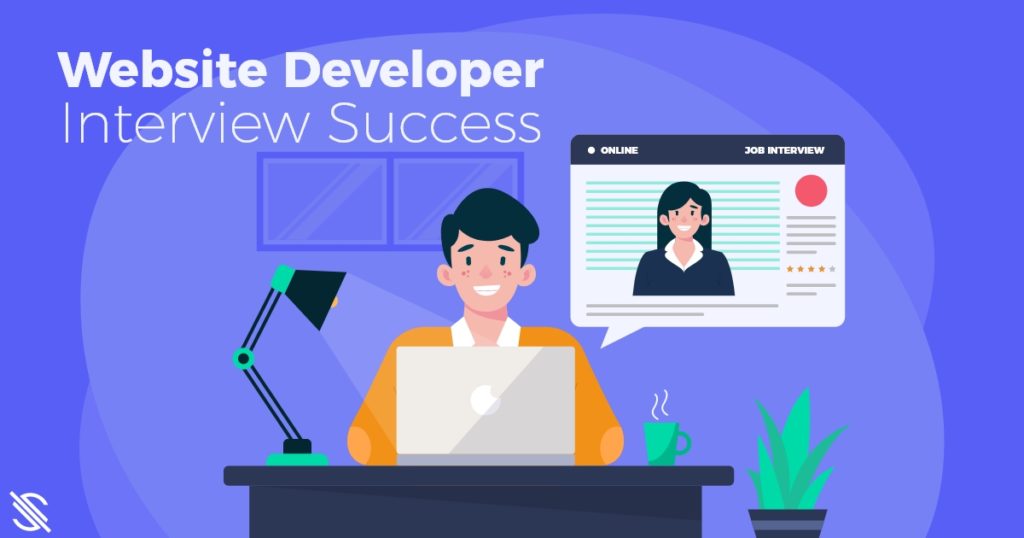
Introduction:
Are you preparing for a website developer interview and feeling overwhelmed by the prospect of facing tough questions? Don’t worry, we’ve got you covered! In this comprehensive guide, we will address the key questions that often arise during website developer interviews and provide valuable insights to help you succeed. Whether you are a seasoned professional with years of experience or a new face in the workforce, nailing these questions can boost your confidence and increase your chances of landing your dream job. So, let’s dive in!
Tell us about yourself and your experience in website development.
When answering this question, make a memorable impression by crafting a concise yet compelling summary of your background. Highlight your relevant education, certifications, and past projects, showcasing your passion for web development and how your skills align with the requirements of the position.
Example: “I have a strong foundation in website development, with a Bachelor’s degree in Computer Science and five years of professional experience. Throughout my career, I have successfully delivered a range of projects, including e-commerce websites, responsive web applications, and content management systems. My expertise lies in front-end development, where I excel in HTML, CSS, and JavaScript. I also have experience working with popular frameworks like React and back-end technologies like Node.js. My ability to collaborate effectively with designers and project stakeholders has allowed me to create engaging and user-friendly websites that drive results.”
What are the essential skills and technologies a website developer should be proficient in?
Demonstrate your knowledge of core skills such as HTML, CSS, JavaScript, and responsive design. Discuss your experience with front-end frameworks like React or Angular and back-end technologies such as PHP or Node.js. Highlight any additional expertise you possess, such as database management, version control, or UX/UI design.
Example: “HTML, CSS, and JavaScript are the building elements of the web, so a competent web developer should have a strong foundation in these languages. Additionally, familiarity with responsive design principles is crucial in today’s mobile-first world. I have hands-on experience with front-end frameworks like React, which enable efficient and modular development, and I am proficient in back-end technologies such as PHP and Node.js. I also have a strong understanding of database management systems, version control tools like Git, and UX/UI design principles, allowing me to create seamless user experiences.”
How do you ensure cross-browser compatibility for websites?
Explain the importance of cross-browser compatibility and how you handle it during development. Discuss techniques like progressive enhancement and graceful degradation to ensure consistent user experiences across different browsers and devices. Mention tools or resources you use, such as browser testing tools or online services.
Example: “Cross-browser compatibility is crucial to provide a seamless experience for users regardless of the browser they choose. During development, I follow industry best practices to ensure compatibility. I employ techniques like progressive enhancement, where I start with a solid foundation of HTML, CSS, and JavaScript that works across all browsers. Then, I gradually add advanced features supported by modern browsers while ensuring graceful degradation for older ones. I also utilize browser testing tools like BrowserStack to simulate different environments and identify and address any compatibility issues.”
Can you explain the concept of responsive web design?
Describe responsive web design and its significance in today’s mobile-centric world. Discuss how you use CSS media queries and fluid layouts to create websites that adapt to various screen sizes and devices. Provide examples of responsive websites you’ve worked on and describe the challenges you faced and how you overcame them.
Example: “Responsive web design is an approach that allows websites to adapt and provide an optimal viewing experience on different devices and screen sizes. By using CSS media queries and fluid layouts, we can adjust the design elements, including font sizes, images, and layout structures, to ensure readability and usability across devices. For example, in a recent project, I developed a responsive e-commerce website that seamlessly transformed from a desktop layout to a mobile-friendly version. To overcome challenges, I conducted thorough testing on various devices and used flexible grid systems to ensure content rearrangement without compromising the user experience.”
How do you optimize website performance and load times?
Highlight your knowledge of performance optimization techniques, such as minification, gzip compression, caching, and lazy loading of assets. Discuss how you analyze and improve website speed using tools like PageSpeed Insights or GTmetrix. Share any success stories of websites you’ve optimized and the impact they had on user experience.
Example: “Website performance plays a crucial role in user satisfaction and engagement. To optimize performance, I employ various techniques such as minifying CSS and JavaScript files, utilizing gzip compression to reduce file sizes, implementing caching mechanisms to store static assets, and employing lazy loading to load images and resources as needed. I also use tools like PageSpeed Insights and GTmetrix to analyze performance metrics and identify areas for improvement. In a recent project, I implemented these optimizations, resulting in a 30% reduction in page load time and significantly improved user experience.”
What security measures do you take during website development?
Demonstrate your understanding of web security best practices. Discuss techniques like input validation, secure coding practices, and protection against common vulnerabilities such as cross-site scripting (XSS) or SQL injection. Mention your familiarity with SSL/TLS certificates and securing sensitive data.
Example: “Ensuring website security is a top priority in my development process. I follow secure coding practices, including input validation to prevent malicious data entry, and I sanitize user inputs to mitigate risks like cross-site scripting (XSS) and SQL injection attacks. I also stay updated with the OWASP Top Ten vulnerabilities to proactively address any potential risks. Implementing SSL/TLS certificates is essential for encrypting data transmission and establishing a secure connection. I am well-versed in configuring HTTPS protocols to protect sensitive information, such as user credentials and payment details.”
How do you handle website accessibility and ensure compliance with accessibility standards?
Highlight your commitment to creating inclusive websites that can be accessed by all users, including those with disabilities. Discuss techniques like semantic HTML, proper use of ARIA attributes, and testing for accessibility compliance using tools like WAVE or Lighthouse. Share examples of websites you’ve developed with accessibility in mind.
Example: “Website accessibility is a core aspect of my development approach. I adhere to accessibility standards and guidelines, such as using semantic HTML to provide a logical structure to web content and leveraging ARIA attributes for enhanced screen reader compatibility. I also conduct thorough accessibility testing using tools like WAVE or Lighthouse to ensure compliance and address any issues. In a recent project, I integrated accessibility features, including proper heading structure and alternative text for images, resulting in an improved experience for users with disabilities.”
Can you describe your approach to debugging and troubleshooting website issues?
Explain how you identify and resolve website bugs and issues. Discuss your use of developer tools, browser consoles, and debugging techniques. Emphasize your problem-solving skills and ability to work effectively under pressure to deliver timely solutions.
Example: “Debugging and troubleshooting are integral parts of my development process. When encountering website issues, I systematically identify the problem by utilizing developer tools and a browser console to examine error messages, log output, and network requests. I also use breakpoints to analyze code execution and step through the code to pinpoint the source of the issue. Additionally, I employ logging and error-tracking tools to capture and analyze errors in production environments. My problem-solving skills and ability to remain focused under pressure have allowed me to quickly resolve issues and ensure the smooth functioning of websites.”
How do you stay updated with the latest trends and technologies in web development?
Demonstrate your commitment to continuous learning and professional growth. Mention resources you regularly follow, such as industry blogs, online communities, or conferences. Highlight any recent projects or personal initiatives that showcase your willingness to adapt and embrace new technologies.
Example: “I am passionate about staying abreast of the latest trends and technologies in web development. I actively engage with industry blogs like Smashing Magazine and A List Apart, where industry experts share insights and best practices. I also participate in online communities, such as Stack Overflow and GitHub, to learn from and collaborate with other developers. Additionally, I attend web development conferences and workshops to gain knowledge about emerging tools and frameworks. As a testament to my commitment, I recently completed a personal project where I explored and implemented a modern JavaScript framework, demonstrating my ability to adapt and embrace new technologies.”
Do you have any experience working in an Agile development environment?
If you have experience working in Agile methodologies like Scrum or Kanban, share your role and responsibilities within the team. Discuss your ability to collaborate, adapt to changing requirements, and deliver incremental updates. Highlight any success stories that demonstrate your effectiveness in an Agile environment.
Example: “I have extensive experience working in Agile development environments, particularly with the Scrum methodology. In previous roles, I served as a key member of cross-functional teams, collaborating closely with product owners, designers, and other developers. My responsibilities included participating in sprint planning, daily stand-up meetings, and sprint reviews. I excel at adapting to changing requirements and prioritizing tasks to deliver incremental updates within the designated time frames. In a recent project, our team successfully delivered a complex website feature within a tight deadline by leveraging Agile principles. The iterative approach allowed us to incorporate client feedback at each sprint, resulting in a highly satisfied client and a successful product launch.”
Conclusion:
Mastering the key questions discussed in this guide can significantly enhance your chances of success in a website developer interview. Remember to tailor your responses to showcase your unique skills and experiences. Additionally, ongoing self-improvement is crucial in the ever-evolving field of web development. To further accelerate your career growth and explore exciting opportunities, visit Simphini (simphini.com). Our platform offers a wealth of resources, courses, and a supportive community to help you excel in your web development journey. Best of luck with your interviews and keep pushing your boundaries to achieve your career goals!
